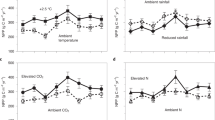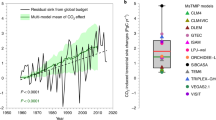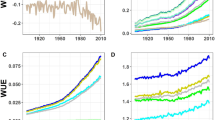Abstract
Historically, studies of the greenhouse effect of carbon dioxide (CO2) have dealt primarily with temperature and only secondarily with precipitation. In the latest report on this topic1, however, the subject of streamflow is broached with an analysis2 which suggests that watersheds in the western United States will suffer 40–75% reductions in streamflow for a doubling of the atmospheric CO2 content, leading to a 2 °C rise in air temperature and a 10% drop in precipitation. A shortcoming of that study is that it does not include the direct antitranspirant effect of atmospheric CO2 enrichment that would accompany any CO2-induced climatic change, whereby increasing CO2 content of the air tends to induce partial stomatal closure, so reducing plant transpiration and thereby conserving soil moisture and increasing runoff to streams. Inclusion of this latter effect in a simple model of watershed runoff applied to 12 drainage basins in Arizona indicates that 40–60% increases in streamflow may well be the more likely consequences of a CO2 concentration doubling, even in the face of adverse changes in temperature and precipitation.
This is a preview of subscription content, access via your institution
Access options
Subscribe to this journal
Receive 51 print issues and online access
$199.00 per year
only $3.90 per issue
Buy this article
- Purchase on Springer Link
- Instant access to full article PDF
Prices may be subject to local taxes which are calculated during checkout
Similar content being viewed by others
References
Carbon Dioxide Assessment Committee, US National Research Council Changing Climate (National Academy Press, Washington DC, 1983).
Revelle, R. R. & Waggoner, P. E. in Changing Climate 419–432 (National Academy Press, Washington DC, 1983).
Langbein, W. B. et al. Annual Runoff in the United States, U. S. Geol. Surv. Circ. No. 5 (US Department of the Interior, Washington, DC, 1949).
Brazel, A. J. & Idso, S. B. Implications of the Rapidly Rising CO2 Content of Earth's Atmosphere for Water Resources in Arizona (Climatol. Publ. Sci. Pap. No. 19, Laboratory of Climatology, Arizona State University, 1984).
Brazel, A. J. et al. Final Report Arizona Climate Inventory Vol 1 (Laboratory of Climatology, Arizona State University, 1981).
US Geological Survey Water Resources Data Arizona Water Year 1981 (Water-Data Report AZ-81-1 1983).
Kimball, B. A. & Idso, S. B. Agric. Wat. Managmnt 7, 55–73 (1983).
Rogers, H. H., Thomas, J. F. & Bingham, G. E. Science 220, 428–429 (1983).
Brown, D. E. (ed.) Biotic Communities of the American Southwest—United States and Mexico, J. Desert Plants Vol. 4, No. 1-4 (Boyce Thompson Arboretum, 1982).
Aston, A. R. J. Hydrol. 67, 273–280 (1984).
Idso, S. B. & Quinn, J. A. Vegetational redistribution in Arizona and New Mexico in Response to a Doubling of the Atmospheric CO2 Concentration (Climatol. Publ. Sci. Pap. No. 17, Laboratory of Climatology, Arizona State University, 1983).
Idso, S. B. Carbon Dioxide: Friend or Foe? An Inquiry into the Climatic and Agricultural Consequences of the Rapidly Rising CO2 Content of Earth's Atmosphere (IBR Press, Tempe, 1982).
Author information
Authors and Affiliations
Rights and permissions
About this article
Cite this article
Idso, S., Brazel, A. Rising atmospheric carbon dioxide concentrations may increase streamflow. Nature 312, 51–53 (1984). https://doi.org/10.1038/312051a0
Received:
Accepted:
Issue Date:
DOI: https://doi.org/10.1038/312051a0
This article is cited by
-
Soil–vegetation moisture capacitor maintains dry season vegetation productivity over India
Scientific Reports (2023)
-
Analysis of the groundwater scenario with respect to the crop water productivity for the Betwa–Dhasan river basin, Bundelkhand using remote sensing techniques
Journal of Earth System Science (2021)
-
Mid-latitude freshwater availability reduced by projected vegetation responses to climate change
Nature Geoscience (2019)
-
Changes in vegetation and surface water balance at basin-scale in Central China with rising atmospheric CO2
Climatic Change (2019)
-
Probabilistic simulations of the impact of increasing leaf-level atmospheric carbon dioxide on the global land surface
Climate Dynamics (2010)
Comments
By submitting a comment you agree to abide by our Terms and Community Guidelines. If you find something abusive or that does not comply with our terms or guidelines please flag it as inappropriate.



